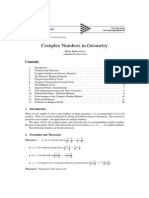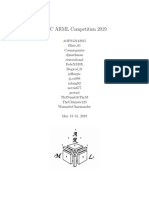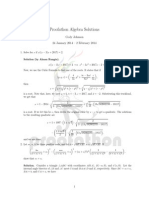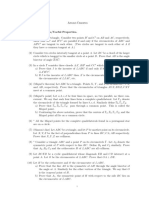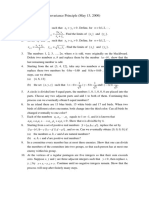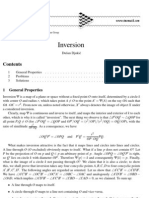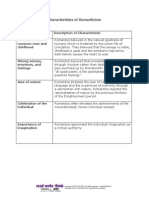Combinatorics
Uploaded by
ayu7kajiCombinatorics
Uploaded by
ayu7kajiEPGY
Math Olympiad
Math Olympiad Problem Solving Stanford University EPGY Summer Institutes 2008 Combinatorics Olympiad Problems
1. Twenty-one girls and twenty-one boys took part in a mathematical competition. It turned out that each contestant solved at most six problems, and for each pair of a girl and a boy, there was at least one problem that was solved by both the girl and the boy. Show that there is a problem that was solved by at least three girls and at least three boys. 2. A walk consists of a sequence of steps of length 1 taken in directions north, south, east, or west. A walk is called self-avoiding if it never passes through the same point twice. Let f (n) denote the number of n-step self-avoiding walks which begin at the origin. Show that 2n < f (n) 4 3n1 . 3. Let n be a xed positive integer. Find the sum of all positive integers with the following property: In base 2, it has exactly 2n digits consisting of n 1s and n 0s. The rst digit cannot be 0. 4. Let n be an even integer not less than 4. A cube with edge n in length (an n3 dierent colors given n-cube) is constructed from n3 unit cubes. There are 4 and exactly 4 unit cubes are colored in each of these given colors. Prove that one can choose n unit cubes of dierent colors, no two of which are in the same level (a level is a set of n2 unit cubes whose centers lie in a plane parallel to one of the faces of the n-cube). 5. Suppose that 7 boys and 13 girls line up in a row. Let S be the number of places in the row where a boy and a girl are standing next to each other. For example, for the row GBBGGGBGBGGGBGBGGBGG we have S = 12. If all possible orders of these 20 people are considered, what is the average value of S ? Generalize this result to a group of m boys and n girls. 6. Let n be an odd integer greater than 1. Find the number of permutations p of the set {1, 2, . . . , n} such that |p(1) 1| + |p(2) 2| + + |p(n) n| = n2 1 . 2
Summer 2008
Problem Set: Combinatorics
EPGY
Math Olympiad
7. In a sequence of coin tosses, one can keep a record of the number of instances when a tail is immediately followed by a head, a head is immediately followed by a head, etc. We denote these by T H, HH , etc. For example, in the sequence HHT T HHHHT HHT T T T of 15 coin tosses, we observe that there are ve H, H , three HT , two T H , and four T T subsequences. How many dierent sequences of 15 coin tosses will contain exactly two HH , three HT , four T H , and ve T T subsequences? 8. Determine the smallest integer n, n 4, for which one can choose four dierent numbers a, b, c, d from any n distinct integers such that a + b c d is divisible by 20. 9. Let m and n be positive integers. Suppose that a given rectangle can be tiled by a combination of horizontal 1 m strips and vertical n 1 strips. Prove that it can be tiled using only one of the two types. 10. A subset M of {1, 2, 3, . . . , 15} does not contain three elements whose product is a perfect square. Determine the maximum number of elements of M .
Summer 2008
Problem Set: Combinatorics
You might also like
- Purple Comet Math Meet Next 10 Years Look InsideNo ratings yetPurple Comet Math Meet Next 10 Years Look Inside14 pages
- Marko Radovanovic Complex Numbers in GeometryNo ratings yetMarko Radovanovic Complex Numbers in Geometry53 pages
- Syllabus: 1. Polynomials A 2. Polynomials BNo ratings yetSyllabus: 1. Polynomials A 2. Polynomials B4 pages
- Proving Some Geometric Inequalities by Using Complex Numbers - Titu Andreescu and Dorin AndricaNo ratings yetProving Some Geometric Inequalities by Using Complex Numbers - Titu Andreescu and Dorin Andrica8 pages
- IMO 2021 Training Week 2: 1 In-Class ProblemsNo ratings yetIMO 2021 Training Week 2: 1 In-Class Problems3 pages
- Mathematical Excalibur - Pole and Polar PDFNo ratings yetMathematical Excalibur - Pole and Polar PDF4 pages
- Hojoo Lee & Peter Vandendriessche - Problems in Elementary Number Theory100% (1)Hojoo Lee & Peter Vandendriessche - Problems in Elementary Number Theory88 pages
- Doomsday Mathematical Olympiad: 2 Set of Sample ProblemsNo ratings yetDoomsday Mathematical Olympiad: 2 Set of Sample Problems13 pages
- 2016-03-31 The Incenter-Excenter Lemma, by Evan Chen PDFNo ratings yet2016-03-31 The Incenter-Excenter Lemma, by Evan Chen PDF4 pages
- Stanford University EPGY Summer Institutes 2008 Math Olympiad Problem SolvingNo ratings yetStanford University EPGY Summer Institutes 2008 Math Olympiad Problem Solving4 pages
- UNSW Maths Competition 2006 & SolutionsNo ratings yetUNSW Maths Competition 2006 & Solutions10 pages
- Bijective Proofs - Maria Monks - MOP (Blue) 2011No ratings yetBijective Proofs - Maria Monks - MOP (Blue) 20113 pages
- Projectiles Launched at An Angle - EducationNo ratings yetProjectiles Launched at An Angle - Education6 pages
- Green: Grene Grēne Ghrē - (Die) Grünen GrünNo ratings yetGreen: Grene Grēne Ghrē - (Die) Grünen Grün6 pages
- Ben Agger Critical Theory Poststruct Post ModNo ratings yetBen Agger Critical Theory Poststruct Post Mod28 pages
- Leading the Way in Financial Excellence: M&M AL MENHALI AUDITING, Dubai's Top Accounting FirmNo ratings yetLeading the Way in Financial Excellence: M&M AL MENHALI AUDITING, Dubai's Top Accounting Firm7 pages
- Dermatoglyphics: A Brief Review: January 2016No ratings yetDermatoglyphics: A Brief Review: January 20166 pages
- U of H Open Records Complaint To Texas Attorney GeneralNo ratings yetU of H Open Records Complaint To Texas Attorney General21 pages
- Unsupervised Learning of Video Representations Using LstmsNo ratings yetUnsupervised Learning of Video Representations Using Lstms12 pages
- Read The Extract From The Short Story QWERTYUIOP Below and Answer The Questions That FollowNo ratings yetRead The Extract From The Short Story QWERTYUIOP Below and Answer The Questions That Follow6 pages
- Data Analysis With Excel Practical FileNo ratings yetData Analysis With Excel Practical File34 pages






